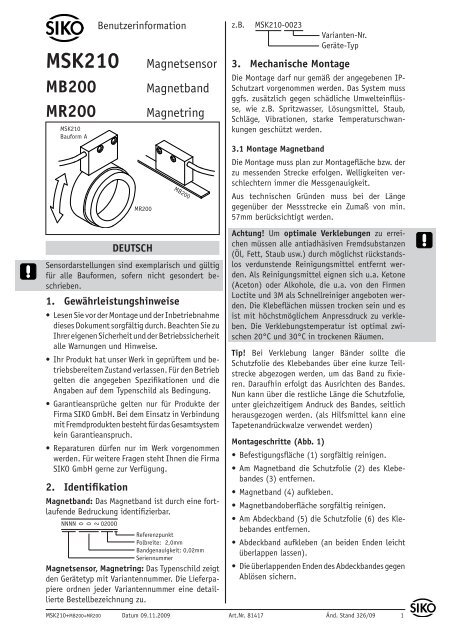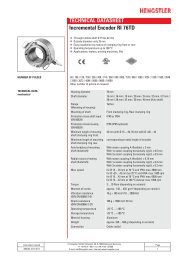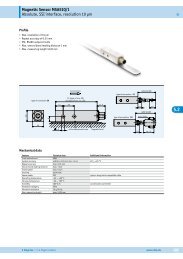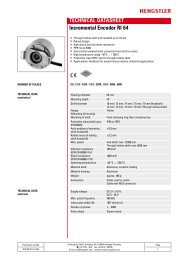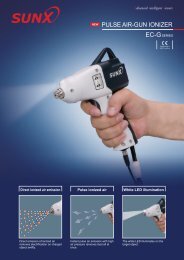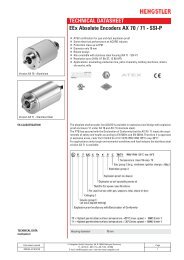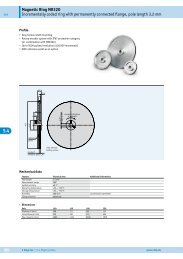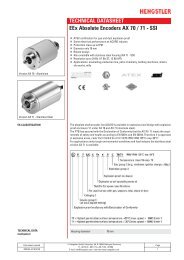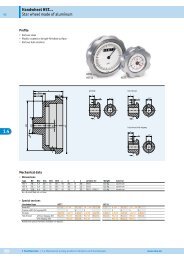MB200 MR200 - Acumo
MB200 MR200 - Acumo
MB200 MR200 - Acumo
Erfolgreiche ePaper selbst erstellen
Machen Sie aus Ihren PDF Publikationen ein blätterbares Flipbook mit unserer einzigartigen Google optimierten e-Paper Software.
MSK210<br />
<strong>MB200</strong><br />
<strong>MR200</strong><br />
MSK210<br />
Bauform A<br />
<strong>MR200</strong><br />
DEUTSCH<br />
<strong>MB200</strong><br />
Sensordarstellungen sind exemplarisch und gültig<br />
für alle Bauformen, sofern nicht gesondert beschrieben.<br />
1. Gewährleistungshinweise<br />
• Lesen Sie vor der Montage und der Inbetriebnahme<br />
dieses Dokument sorgfältig durch. Beachten Sie zu<br />
Ihrer eigenen Sicherheit und der Betriebssicherheit<br />
alle Warnungen und Hinweise.<br />
• Ihr Produkt hat unser Werk in geprüftem und betriebsbereitem<br />
Zustand verlassen. Für den Betrieb<br />
gelten die angegeben Spezifikationen und die<br />
Angaben auf dem Typenschild als Bedingung.<br />
• Garantieansprüche gelten nur für Produkte der<br />
Firma SIKO GmbH. Bei dem Einsatz in Verbindung<br />
mit Fremdprodukten besteht für das Gesamtsystem<br />
kein Garantieanspruch.<br />
• Reparaturen dürfen nur im Werk vorgenommen<br />
werden. Für weitere Fragen steht Ihnen die Firma<br />
SIKO GmbH gerne zur Verfügung.<br />
2. Identifikation<br />
Benutzerinformation<br />
Magnetsensor<br />
Magnetband<br />
Magnetring<br />
Magnetband: Das Magnetband ist durch eine fortlaufende<br />
Bedruckung identifizierbar.<br />
NNNN<br />
0<br />
0<br />
2<br />
0200O<br />
Referenzpunkt<br />
Polbreite: 2,0mm<br />
Bandgenauigkeit: 0,02mm<br />
Seriennummer<br />
Magnetsensor, Magnetring: Das Typenschild zeigt<br />
den Gerätetyp mit Variantennummer. Die Lieferpapiere<br />
ordnen jeder Variantennummer eine detaillierte<br />
Bestellbezeichnung zu.<br />
z.B.<br />
MSK210-0023<br />
Varianten-Nr.<br />
Geräte-Typ<br />
3. Mechanische Montage<br />
Die Montage darf nur gemäß der angegebenen IP-<br />
Schutzart vorgenommen werden. Das System muss<br />
ggfs. zusätzlich gegen schädliche Umwelteinflüsse,<br />
wie z.B. Spritzwasser, Lösungsmittel, Staub,<br />
Schläge, Vibrationen, starke Temperaturschwankungen<br />
geschützt werden.<br />
3.1 Montage Magnetband<br />
Die Montage muss plan zur Montagefläche bzw. der<br />
zu messenden Strecke erfolgen. Welligkeiten verschlechtern<br />
immer die Messgenauigkeit.<br />
Aus technischen Gründen muss bei der Länge<br />
gegenüber der Messstrecke ein Zumaß von min.<br />
57mm berücksichtigt werden.<br />
Achtung! Um optimale Verklebungen zu erreichen<br />
müssen alle antiadhäsiven Fremdsubstanzen<br />
(Öl, Fett, Staub usw.) durch möglichst rückstandslos<br />
verdunstende Reinigungsmittel entfernt werden.<br />
Als Reinigungsmittel eignen sich u.a. Ketone<br />
(Aceton) oder Alkohole, die u.a. von den Firmen<br />
Loctite und 3M als Schnellreiniger angeboten werden.<br />
Die Klebeflächen müssen trocken sein und es<br />
ist mit höchstmöglichem Anpressdruck zu verkleben.<br />
Die Verklebungstemperatur ist optimal zwischen<br />
20°C und 30°C in trockenen Räumen.<br />
Tip! Bei Verklebung langer Bänder sollte die<br />
Schutzfolie des Klebebandes über eine kurze Teilstrecke<br />
abgezogen werden, um das Band zu fixieren.<br />
Daraufhin erfolgt das Ausrichten des Bandes.<br />
Nun kann über die restliche Länge die Schutzfolie,<br />
unter gleichzeitigem Andruck des Bandes, seitlich<br />
herausgezogen werden. (als Hilfsmittel kann eine<br />
Tapetenandrückwalze verwendet werden)<br />
Montageschritte (Abb. 1)<br />
• Befestigungsfläche (1) sorgfältig reinigen.<br />
• Am Magnetband die Schutzfolie (2) des Klebebandes<br />
(3) entfernen.<br />
• Magnetband (4) aufkleben.<br />
• Magnetbandoberfläche sorgfältig reinigen.<br />
• Am Abdeckband (5) die Schutzfolie (6) des Klebebandes<br />
entfernen.<br />
• Abdeckband aufkleben (an beiden Enden leicht<br />
überlappen lassen).<br />
• Die überlappenden Enden des Abdeckbandes gegen<br />
Ablösen sichern.<br />
MSK210+<strong>MB200</strong>+<strong>MR200</strong> Datum 09.11.2009 Art.Nr. 81417 Änd. Stand 326/09 1
Abb. 1: Montage Magnetband<br />
Achtung! Die Beeinflussung durch magnetische<br />
Felder ist zu vermeiden. Insbesondere dürfen keine<br />
Magnetfelder (z.B. Haftmagnete oder andere Dauermagnete)<br />
in direkten Kontakt mit dem Magnetband<br />
geraten. In stromlosem Zustand werden Bewegungen<br />
oder Verstellungen des Magnetsensors<br />
von der Folgeelektronik nicht erkannt und erfasst.<br />
Montagebeispiele<br />
Die einfache Montageart, durch angeschrägtes<br />
Schutzband (Abb. 2), ist nur in sehr geschützter Umgebung<br />
zu empfehlen. Bei ungeschützer Umgebung<br />
besteht Abschälgefahr. In solchen Fällen sind Montagearten,<br />
wie in Abb. 3 und 4 gezeigt, geeigneter.<br />
Den optimalen Schutz bietet die Montage in einer<br />
Nut (Abb. 5), die so tief sein sollte, dass das Magnetband<br />
vollständig darin eingebettet werden kann.<br />
3.3 Montage Magnetsensor MSK210<br />
Der Magnetsensor MSK210, Bauform A kann durch<br />
Verwendung von 2 Schrauben M3 über die ø3,5mm<br />
Durchgangslöcher befestigt werden. Es wird empfohlen<br />
die beiliegenden Befestigungsschrauben und Federringe<br />
zu verwenden (Anzugsmoment 0,25Nm).<br />
• Kabel sind so zu verlegen, dass keine Beschädigungsgefahr<br />
besteht. Zugentlastung und wenn nötig<br />
Schleppkette oder Schutzschlauch vorsehen.<br />
• Auf richtige Ausrichtung bezüglich der Zählrichtung<br />
achten (Abb. 6+7). Dies ist unerheblich<br />
falls sich die Zählrichtung in der elektronischen<br />
Auswertung umkehren lässt (wie z.B. bei den<br />
Magnetbandanzeigen von SIKO).<br />
Achtung! Die Toleranz- und Abstandsmaße müssen<br />
über die gesamte Messstrecke eingehalten werden.<br />
Anwendung LINEAR MSK210 mit <strong>MB200</strong>:<br />
Verfahrrichtung<br />
Signal A vor B<br />
Kabelabgangsrichtung<br />
aktive Seite<br />
0.1mm ... 1.0mm<br />
ohne Referenzpunkt<br />
0.1mm ... 0.4mm<br />
mit Referenzpunkt<br />
Abstand Sensor/Magnetband<br />
< 1° < 3°<br />
Abb. 2 Abb. 3<br />
Maximale Fluchtungsfehler<br />
< 1°<br />
Abb. 4 Abb. 5<br />
Referenzpunktlage zur<br />
Magnetbandbedruckung<br />
Zul. Abweichung<br />
Mitte Band/Sensor:<br />
ohne Ref. ±2mm<br />
mit Ref. ±0.5mm<br />
3.2 Montage Magnetring <strong>MR200</strong><br />
Nach dem Aufschieben des Magnetringes auf die<br />
Welle wird durch Anziehen des Gewindestiftes M6<br />
der <strong>MR200</strong> mit der Welle verbunden.<br />
• Zwischen Welle und dem <strong>MR200</strong> ist ein Schiebesitz<br />
vorzusehen.<br />
• Der Magnetring <strong>MR200</strong> muss möglichst kraftund<br />
spannungsfrei montiert werden. Eventuell<br />
erforderliche Belastungen sind am Metallflansch<br />
aufzubringen. Schläge auf den Magnetring sind<br />
zu vermeiden.<br />
• Ein Wellenfreistich entsprechend Abb. 6 wird<br />
empfohlen<br />
Referenzpunkt periodisch<br />
50<br />
Lage Ref.Punkt P=entspr. Lieferpapiere<br />
Einmaliger Referenzpunkt<br />
Lage Ref.Punkt E=entspr. Lieferpapiere<br />
min. 0,05m<br />
Symbolische Darstellung<br />
der Pole<br />
Abb. 6: Definition der Zählrichtung mit Magnetband und<br />
Montage Sensor Magnetband, Abstandsmaße, Toleranzen<br />
2 MSK210+<strong>MB200</strong>+<strong>MR200</strong> Datum 09.11.2009 Art.Nr. 81417 Änd. Stand 326/09
Anwendung RADIAL MSK210 mit <strong>MR200</strong>:<br />
0.1mm ... 0.8mm ohne Referenzpunkt<br />
0.1mm ... 0.4mm mit Referenzpunkt<br />
Kabelabgangsrichtung<br />
Signal<br />
A vor B<br />
< 1°<br />
< 3°<br />
Freistich an<br />
der Vollwelle<br />
für Gewindestift<br />
wird<br />
empfohlen<br />
Referenzpunkt<br />
Drehrichtung Magnetring<br />
Zul. Abweichung<br />
Mitte Band/Sensor:<br />
ohne Ref. ±2mm<br />
mit Ref. ±0.5mm<br />
Abb.7: Definition der Zählrichtung mit Magnetring<br />
und Montage Sensor/Magnetring, Abstandsmaße,<br />
Toleranzen<br />
4. Elektrischer Anschluss<br />
• Verdrahtungsarbeiten dürfen nur spannungslos<br />
erfolgen!<br />
• Vor dem Einschalten sind alle Leitungsanschlüsse<br />
und Steckverbindungen zu überprüfen.<br />
Hinweise zur Störsicherheit<br />
Alle Anschlüsse sind gegen äußere Störeinflüsse<br />
geschützt. Der Einsatzort ist aber so zu wählen,<br />
dass induktive oder kapazitive Störungen nicht<br />
auf den Sensor oder dessen Anschlussleitung<br />
einwirken können! Durch geeignete Kabelführung<br />
und Verdrahtung können Störeinflüsse (z.B.von<br />
Schaltnetzteilen, Motoren, getakteten Reglern<br />
oder Schützen) vermindert werden.<br />
Erforderliche Maßnahmen:<br />
• Nur geschirmtes Kabel verwenden. Den Kabelschirm<br />
beidseitig auflegen. Litzenquerschnitt der<br />
Leitungen min. 0,14mm²; max. 0,5mm².<br />
• Die Verdrahtung von Abschirmung und Masse (0V)<br />
muss sternförmig und großflächig erfolgen. Der Anschluss<br />
der Abschirmung an den Potentialausgleich<br />
muss großflächig (niederimpedant) erfolgen.<br />
• Das System muss in möglichst großem Abstand von<br />
Leitungen eingebaut werden, die mit Störungen<br />
belastet sind; ggfs. sind zusätzliche Maßnahmen<br />
wie Schirmbleche oder metallisierte Gehäuse<br />
vorzusehen. Leitungsführungen parallel zu Energieleitungen<br />
vermeiden.<br />
• Schützspulen müssen mit Funkenlöschgliedern<br />
beschaltet sein.<br />
Spannungsversorgung<br />
Die Spannungswerte sind abhängig von der Sensorausführung<br />
und sind den Lieferpapieren sowie<br />
dem Typenschild zu entnehmen.<br />
Aderendhülsen aufquetschen.<br />
so kurz wie<br />
möglich<br />
Schirm<br />
Abb. 8: Anschluss E1<br />
z.B.: 24 VDC ±20%<br />
Achtung! Die maximale Länge des Anschlusskabels<br />
zwischen Sensor und Nachfolgeelektronik beachten.<br />
4.1 Anschlussarten / Anschlussbelegung<br />
E1: Anschluss mit offenen Kabelenden.<br />
Achtung! Verzinnte Litzen dürfen nicht in Verbindung<br />
mit Schraubklemmverbindungen eingesetzt<br />
werden.<br />
Signal<br />
1.<br />
2.<br />
3.<br />
4.<br />
nicht<br />
invertiert<br />
invertiert<br />
invertiert mit<br />
Referenzsignal<br />
A rot rot rot<br />
B orange orange orange<br />
I - - - - - - blau<br />
+UB braun braun braun<br />
GND schwarz schwarz schwarz<br />
A/ - - - gelb gelb<br />
B/ - - - grün grün<br />
I/ - - - - - - violett<br />
Ummantelung entfernen.<br />
Schirm auftrennen und verdrillen.<br />
Litzen ca. 5mm abisolieren und verdrillen.<br />
E6: Anschluss mit Kupplungsstecker und Kupplungsdose.<br />
Steckermontage entsprechend Abb. 9.<br />
1.<br />
2.<br />
3.<br />
4.<br />
5.<br />
6.<br />
7.<br />
Pos. 6 ... 10 über Kabelmantel schieben.<br />
Kabel abisolieren.<br />
Schirm umlegen.<br />
Pos. 5 auf Litzen schieben.<br />
Litzen an Pos. 3 löten (entspr. Anschlussplan).<br />
Abstandhülse Pos. 4 aufweiten und über Litzen<br />
stülpen, zusammendrücken und auf Pos. 3 stecken.<br />
Schlitz und Nut (Pos. 3 und 4) müssen<br />
deckungsgleich sein.<br />
Pos. 6 an Pos. 5 drücken, überstehen der Schirm<br />
abschneiden.<br />
MSK210+<strong>MB200</strong>+<strong>MR200</strong> Datum 09.11.2009 Art.Nr. 81417 Änd. Stand 326/09 3
8.<br />
9.<br />
Pos. 2 und 7 aufschieben und mittels Montagewerkzeug<br />
Pos. 11 verschrauben.<br />
Pos. 8 in Pos. 9 stecken, beides in Pos. 7<br />
schieben.<br />
10. Pos. 10 mit Pos. 7 verschrauben.<br />
11. Pos. 1 in Pos. 2 schieben.<br />
Buchsenteil<br />
Schirm<br />
6. Fehlerbehandlung<br />
Typische Fehler, die bei Anbau und Betrieb auftreten:<br />
• Das Magnetband wurde falsch montiert /aktive<br />
Seite nach unten (siehe Kap. 3.1).<br />
• Zum Schutz des Magnetbandes wurde nicht das<br />
mitgelieferte Abdeckband verwendet. Das Abdeckband<br />
muss nicht magnetisierbar sein.<br />
• Der Sensor ist nicht, oder nicht korrekt angeschlossen<br />
(Pinbelegung Kap. 4.2).<br />
• Die Abstandstoleranz zwischen Sensor und Magnetband/Magnetring<br />
wurde nicht eingehalten<br />
(beim Band über die gesamte Messstrecke!), der<br />
Sensor streift auf dem Magnetring (Abb. 6+7).<br />
• Kabelunterbrechung / Abtrennung durch scharfe<br />
Kanten / Quetschung.<br />
• Der Sensor ist mit der aktiven Seite vom Band<br />
abgewandt montiert (Abb. 6+7).<br />
• Der Sensor wurde nicht entsprechend Abb. 6+7<br />
ausgerichtet.<br />
Stiftteil<br />
Abb. 9: Montage Anschlussart E6<br />
E8: Anschluss mit 9-pol. D-SUB Stiftkontakt und<br />
Buchsenkontakt.<br />
Signal<br />
Ansichtseite = Steckseite<br />
nicht<br />
invertiert<br />
invertiert<br />
invertiert mit<br />
Referenzsignal<br />
E6 E8 E6 E8 E6 E8<br />
A PIN 3 PIN 3 PIN 1 PIN 1 PIN 1 PIN 1<br />
B 4 4 2 2 2 2<br />
I - - - - - - - - - - - - 3 3<br />
+UB 2 2 4 4 4 4<br />
GND 1 1 5 5 5 5<br />
A/ - - - - - - 6 6 6 6<br />
B/ - - - - - - 7 7 7 7<br />
I/ - - - - - - - - - - - - 8 8<br />
- - - 5-7 5-9 3 3, 8, 9 9<br />
5. Wartung<br />
Die Oberfläche des Magnetbandes ist bei starker<br />
Verschmutzung durch Staub, Späne, Feuchtigkeit<br />
usw., von Zeit zu Zeit mit einem weichen Lappen<br />
zu reinigen.<br />
4 MSK210+<strong>MB200</strong>+<strong>MR200</strong> Datum 09.11.2009 Art.Nr. 81417 Änd. Stand 326/09
MSK210<br />
Design A<br />
<strong>MR200</strong><br />
ENGLISH<br />
<strong>MB200</strong><br />
Exemplary sensor illustrations are valid for all sensor<br />
types unless described separately.<br />
1. Warranty information<br />
• In order to carry out installation correctly, we<br />
strongly recommend this document is read very<br />
carefully. This will ensure your own safety and<br />
the operating reliability of the device.<br />
• Your device has been quality controlled, tested<br />
and is ready for use. Please observe all warnings<br />
and information which are marked either directly<br />
on the device or specified in this document.<br />
• Warranty can only be claimed for components<br />
supplied by SIKO GmbH. If the system is used<br />
together with other products, there is no warranty<br />
for the complete system.<br />
• Repairs should be carried out only at our works.<br />
If any information is missing or unclear, please<br />
contact the SIKO sales staff.<br />
2. Identification<br />
User Information<br />
MSK210 Magnetic sensor<br />
<strong>MB200</strong> Magnetic strip<br />
<strong>MR200</strong> Magnetic ring<br />
Magnetic strip: identification by printing on the<br />
strip.<br />
NNNN<br />
0<br />
0<br />
2<br />
0200O<br />
reference point<br />
pole pitch: 2,0mm<br />
accuracy: 0,02mm<br />
serial number<br />
Magnetic sensor, Magnetic ring: Please check<br />
the particular type of unit and type number from<br />
the identification plate. Type number and the corresponding<br />
version are indicated in the delivery<br />
documentation.<br />
e.g.<br />
MSK210-0023<br />
3. Installation<br />
version number<br />
type of unit<br />
For mounting, the degree of protection specified<br />
must be observed. If necessary, protect the unit<br />
against environmental influences such as sprayed<br />
water, dust, knocks, extreme temperatures.<br />
3.1 Mounting the magnetic strip<br />
The mounting surface / measuring track must be<br />
flat. Buckles or bumps will lead to measuring inaccuracies.<br />
For technical reasons the strip should be min.<br />
57mm longer than the actual measuring distance.<br />
Attention! To guarantee optimal adhesion oil,<br />
grease dust etc. must be removed by using cleansing<br />
agents which evaporate without leaving residues.<br />
Suitable cleansing agents are eg. ketones<br />
(acetone) or alcohols; Messrs. Loctite and 3M can<br />
both supply such cleansing liquid. Make sure that<br />
the surface to be glued is dry and apply the strip<br />
with maximum pressure. Glueing should preferably<br />
be undertaken at temperatures between 20°C to<br />
30°C and in dry atmosphere.<br />
Advice! When applying long pieces of magnetic<br />
strip do not immediately remove the complete<br />
protective foil, but rather peel back a short part<br />
from the end sufficient to fix the strip. Now align<br />
the strip. As the protective strip is then peeled<br />
back and out press the tape firmly onto the mounting<br />
surface. A wall paper roller wheel could be<br />
used to assist in applying pressure onto the magnetic<br />
strip when fixing it in position.<br />
Mounting steps (see fig. 1)<br />
• Clean mounting surface (1) carefully.<br />
• Remove protective foil (2) from the adhesive<br />
side of the magnetic strip (3).<br />
• Stick down the magnetic strip (4).<br />
• Clean surface of magnetic strip carefully.<br />
• Remove protective foil (6) from adhesive tape on<br />
the cover strip (5).<br />
• Fix cover strip (both ends should slightly overlap).<br />
• Also fix cover strip's ends to avoid unintentional<br />
peeling.<br />
MSK210+<strong>MB200</strong>+<strong>MR200</strong> Datum 09.11.2009 Art.Nr. 81417 Änd. Stand 326/09 5
Fig. 1: Mounting of the magnetic strip<br />
Attention! Do not expose the system to magnetic<br />
fields. Any direct contact of the magnetic strip<br />
with magnetic fields (e.g. adhesive magnets or<br />
other permanent magnets) is to be avoided. Sensor<br />
movements during power loss are not captured<br />
by the follower electronics.<br />
Mounting examples<br />
Mounting with chamfered ends (fig. 2) is not recommended<br />
unless the strip is installed in a safe<br />
and protected place without environmental influences.<br />
In less protected mounting places the strip<br />
may peel. There we recommend mounting accord.<br />
to fig. 3 and 4.<br />
Mounting in a groove (fig. 5) best protects the<br />
magnetic strip. The groove should be deep enough<br />
to totally embed the magnetic strip.<br />
and washer springs (fastening torque 0,25Nm).<br />
• Cables should be layed in such a way that there<br />
is no danger of damaging. Provide ten-sion relief<br />
and drag chain or casing, if necessary.<br />
• Observe the correct alignment with regard<br />
to the counting direction (fig. 6 and 7). This<br />
does not apply if the counting direction can be<br />
reversed in the electronic interpretation (e.g. in<br />
SIKO's magnetic-strip displays).<br />
Attention! The tolerance and gap measures must<br />
be observed over the whole measuring length.<br />
LINEAR application MSK210 with <strong>MB200</strong>:<br />
Travel direction<br />
Signal A before B<br />
Direction of<br />
outgoing cable<br />
active side<br />
0.1mm ... 1.0mm without<br />
reference point<br />
0.1mm ... 0.4mm<br />
with reference point<br />
Gap sensor/magnetic strip<br />
< 1° < 3°<br />
Maximum alignment error<br />
Fig. 2 Fig. 3<br />
< 1°<br />
Admissable deviation<br />
middle of tape/sensor:<br />
without ref. point ±2mm<br />
with ref. point ±0.5mm<br />
Fig. 4 Fig. 5<br />
3.2 Mounting of the magnetic ring <strong>MR200</strong><br />
Slide magnetic ring <strong>MR200</strong> onto the shaft and<br />
then tighten grub screw M6 to fix it to the shaft.<br />
• Ensure sliding fit between shaft and MR320.<br />
• Mount <strong>MR200</strong> without force and without strain.<br />
Possible forces should go to the metal flange.<br />
Avoid knocks on the magnetic ring.<br />
• Provide for a relief groove in the solid shaft<br />
(see fig. 6).<br />
3.3 Mounting of the magnetic sensor MSK210<br />
The magnetic sensor MSK210, design A can be fastened<br />
by using two bolts M3 over the ø3,5mm through<br />
holes. We recommend to use the enclosed fixing screws<br />
Position of the reference point relating to the<br />
marking on the magnetic strip<br />
Periodical reference point<br />
50<br />
Position of the reference point P = as<br />
stated in the delivery documentation<br />
Unique reference point<br />
Position of the reference point E = as stated<br />
in the delivery documentation; min. 0,05m<br />
Magnetic poles<br />
- schema<br />
Fig. 6: Definition of the counting direction with<br />
magnetic strip and assemblage sensor/magnetic ring,<br />
gap measure, tolerances<br />
6 MSK210+<strong>MB200</strong>+<strong>MR200</strong> Datum 09.11.2009 Art.Nr. 81417 Änd. Stand 326/09
RADIAL application MSK210 with <strong>MR200</strong>:<br />
0.1mm ... 0.8mm without reference point<br />
0.1mm ... 0.4mm with reference point<br />
Direction of outgoing cable<br />
Signal<br />
A before B<br />
< 1°<br />
< 3°<br />
Undercut at the<br />
solid shaft for<br />
tread plug is<br />
recommended<br />
Direction of totation of<br />
magnetic ring<br />
reference<br />
point<br />
Admissable deviation<br />
middle of tape/sensor:<br />
without ref. point ±2mm<br />
with ref. point ±0.5mm<br />
Fig. 7: Definition of the counting direction with<br />
magnetic ring and assemblage sensor/magnetic ring,<br />
gap measure, tolerances<br />
4. Electrical connection<br />
• Wiring must only be carried out with power off!<br />
• Check all lines and connections before switching<br />
on the equipment!<br />
Interference and distortion<br />
All connections are protected against the effects<br />
of interference. The location should be selected<br />
to ensure that no capacitive or inductive interferences<br />
can affect the sensor or the connection<br />
lines! Suitable wiring layout and choice<br />
of cable can minimise the effects of interference<br />
(eg. interference caused by SMPS, motors, cyclic<br />
controls and contactors).<br />
Necessary measures:<br />
• Only screened cable should be used. Wire cross section<br />
is to be at least 0,14mm², max. 0,5mm².<br />
• Wiring to the screen and ground (0V) must be<br />
secured to a good point. Ensure that the connection<br />
of the screen and earth is made to a large<br />
surface area with a sound connection to minimise<br />
impedance.<br />
• The system should be positioned well away from<br />
cables with interference; if necessary a protective<br />
screen or metal housing must be provided. The<br />
running of wiring parallel to the mains supply<br />
should be avoided.<br />
• Contactor coils must be linked with spark suppression.<br />
Supply voltage<br />
The voltages depend on the sensor designs; they<br />
are to be taken from the delivery documentation<br />
and the identification plate.<br />
e.g.: 24 VDC ±20%<br />
Attention! When connecting sensor and follower<br />
electronics, please do not exceed the max. admissable<br />
cable length.<br />
4.1 Connection type / Pin outs<br />
E1: Flying leads.<br />
Attention! Tinned strands must not used in combination<br />
with screw/clamp connections.<br />
Signal<br />
1.<br />
2.<br />
3.<br />
4.<br />
not<br />
inverted<br />
screening<br />
inverted<br />
Fig. 8: Connection type E1<br />
as short as<br />
possible<br />
inverted with<br />
reference signal<br />
A red red red<br />
B orange orange orange<br />
I - - - - - - blue<br />
+UB brown brown brown<br />
GND black black black<br />
A/ - - - yellow yellow<br />
B/ - - - green green<br />
I/ - - - - - - violet<br />
Remove cable coating.<br />
Open screening and twist it.<br />
Strip stranded wires to a length of 5mm and<br />
twist them.<br />
Pinch stranded wires.<br />
E6: Connection with plug pin and socket contact.<br />
Plug mounting according to fig. 9.<br />
1.<br />
2.<br />
3.<br />
4.<br />
5.<br />
6.<br />
7.<br />
Slip parts 6 to 10 over outer cable.<br />
Strip cable.<br />
Turn down screening.<br />
Push part 5 onto ferrules.<br />
Solder wires to part 3 (according connection<br />
diagram).<br />
Open spacer (part 4) and put it over ferrules,<br />
squeeze and push it onto part 3. Slot and keyway<br />
of parts 3 and 4 must align.<br />
Press parts 6 and 5 together; cut prodruding<br />
screening.<br />
MSK210+<strong>MB200</strong>+<strong>MR200</strong> Datum 09.11.2009 Art.Nr. 81417 Änd. Stand 326/09 7
8.<br />
9.<br />
Push parts 2 and 7 together and screw part 11<br />
using appropriate tool.<br />
Push part 8 into part 9 and slide both parts<br />
into part 7.<br />
10. Screw parts 10 and 7 together.<br />
11. Push part 1 into part 2.<br />
socket<br />
screening<br />
6. Trouble shooting<br />
Below are some typical errors which may occur during<br />
installation and operation:<br />
• Magnetic strip incorrectly mounted (active surface<br />
must be mounted towards the sensor) (see<br />
chapter 3.1).<br />
• Use of foreign protective strip. Must always be<br />
non-magnetic.<br />
• Sensor not or incorrectly connected (pin connection,<br />
see chapter 4.2).<br />
• Tolerance for the gap between magnetic sensor and<br />
magnetic strip not observed over the total travel<br />
distance. Sensor touches strip (see fig. 6+7).<br />
• Cable squeezed / interrupted / cut by sharp<br />
edges.<br />
• Sensor's active side not mounted towards the<br />
magnetic strip (see fig. 6+7).<br />
• Sensor has not been aligned according to fig.<br />
6+7.<br />
pin<br />
Fig. 9: Mounting connection type E6<br />
E8: Connection with 9 pole D-SUB plug pin and<br />
socket contact.<br />
viewing side = plug-in side<br />
Signal<br />
not<br />
inverted<br />
inverted<br />
inverted with<br />
reference signal<br />
E6 E8 E6 E8 E6 E8<br />
A PIN 3 PIN 3 PIN 1 PIN 1 PIN 1 PIN 1<br />
B 4 4 2 2 2 2<br />
I - - - - - - - - - - - - 3 3<br />
+UB 2 2 4 4 4 4<br />
GND 1 1 5 5 5 5<br />
A/ - - - - - - 6 6 6 6<br />
B/ - - - - - - 7 7 7 7<br />
I/ - - - - - - - - - - - - 8 8<br />
- - - 5-7 5-9 3 3, 8, 9 9<br />
5. Maintenance<br />
We recommend cleaning the magnetic strip’s surface<br />
from time to time with a soft rag. This avoids dirt<br />
(dust, chips, humidity ...) sticking to the strip.<br />
SIKO GmbH<br />
Werk / Factory:<br />
Weihermattenweg 2<br />
79256 Buchenbach-Unteribental<br />
Postanschrift / Postal address:<br />
Postfach 1106<br />
79195 Kirchzarten<br />
Telefon/Phone +49 7661 394-0<br />
Telefax/Fax +49 7661 394-388<br />
E-Mail<br />
info@siko.de<br />
Internet www.siko.de<br />
Service support@siko.de<br />
8 MSK210+<strong>MB200</strong>+<strong>MR200</strong> Datum 09.11.2009 Art.Nr. 81417 Änd. Stand 326/09


